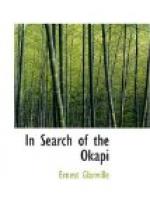“I should be glad to help him there,” said Venning; “but it is too good. He would never take a youngster like me.”
“He said he would rather have a youngster who would carry out his own views about treating a subject, than a man who would try to teach him his business. Come along and see him for yourself.”
“Within half an hour the two friends who had just left school entered a room which was part library, part museum, armoury, dining-room, and cabin, so crammed it was.
“This is my friend Venning, Mr. Hume.”
“Glad to see you, Venning. Sit down anywhere.”
Compton sat down between the horns of a bleached buffalo skull, but Venning stood like one in a trance. His hand had been swallowed up by a huge palm and thick iron-like fingers, and he was staring down on a pair of the broadest shoulders he had seen, with an arching chest to match. This was the pigmy he had imagined—this man with the shoulders of a giant and the chest of a Hercules. Then his eyes ranged over the walls, gradually recovering their animation.
“Know ’em,” said Mr. Hume, waving a bronzed hand towards the wall.
“I think so, sir.”
“Just reel off the names.”
Venning reeled off the names of a score or more of animals without hesitation, and Mr. Hume looked pleased.
“There are some men,” he said, “who come in here and talk over me and round me and under me about fur and feather, and they can’t tell a bighorn from a koodoo by the horns on the wall. Now, my friend, you knew those over there in the corner were the horns of a koodoo, but do you know his habits?”
“No, sir; but I spent a month watching a Dartmoor deer.”
“A month! Can’t learn anything in a month, boy; but you’ve struck the right book. The pages that are spread out under the sky hold the right teaching, for those who wish to learn about animals. There are writers who make a study of structure; they argue from bones, and classify; but bones don’t tell us about the living flesh and blood. You take my meaning?”
“You make a difference between the structure of animals and their habits.”
“That’s so, my lad. Ever read Jeffreys, and the sketches by the ’Son of the Marshes’?”
“They’re splendid.”
Mr. Hume nodded and filled a pipe, having a footlong stem, made out of the wing-bone of an albatross.
“I want to describe the personal habits of animals in their surroundings. I said ‘personal’ habits. Do you take me?”
“No, sir.”
“You think I should use another word, and say, perhaps, ‘distinctive’ habits. I say personal. Now, you take a lion—a bush lion or a veld lion, a yellow lion or a black lion, young or old. That lion, whichever one you take, is a lion by himself. He’s got his own character and his own experience. All lions have ways in common because they’re built alike. They’re heavy and muscular because




